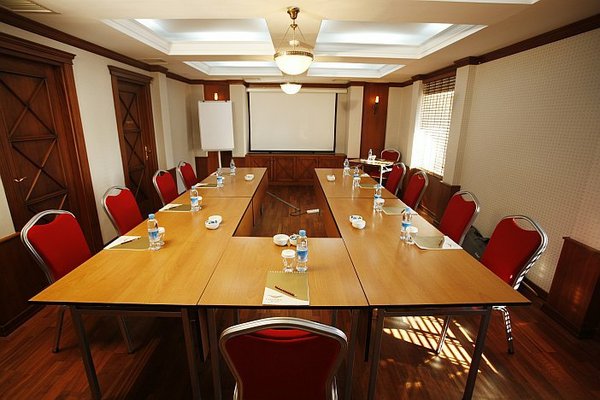
The U.S. Small Business Administration (SBA) reports that there are over 23 million small businesses in America. These account for 55% of all new jobs that are created throughout the country. Despite this, they only hold 30% of commercial space. This discrepancy would seem to suggest that small-business owners are conducting operations outside of their primary locations.
In many of these cases, Intra-Day hotel meeting rooms like those offered by HotelsByDay, remain the best option for small business operations with space limitations. With flexible time bands and a high quality standard, they’re generally a better solution than renting conference space. Outside of the traditional office environment, employees can get distracted. Combatting this, we’ve put together six strategies to help you stay on track and maintain productivity during your hotel meeting.
-
Set an Agenda
The ultimate success or failure of a business can often be attributed to decisions made in company meetings. According to the Houston Chronicle, an agenda is essential in keeping the conference on track and productive. Not only can it boost attendance rates, but it also encourages employees to prepare and be active in the gathering.
-
Limit Attendance
There are a lot of phrases like “Too many cooks in the kitchen,” and they all reference the same problem. This applies to business conferences a well. Sometimes, extra people are added to the list of attendees out of fear of making someone feel left out or managers add in subordinates to support their opinions. While diverse input is valuable, an overfilled roster can totally derail a session. The most effective meetings tend to be those that are intimate enough to support meaningful dialogue between the essential parties.
-
Keep Data Close
Fast Company is quick to point out that a clinical setting isn’t always best. Many corporations invest in large meeting halls, which can be sterile and intimidating, thus inhibiting the free flow of discussion and the productive exchange of ideas. However, an even greater concern is that attendees are isolated from vital sources of information. They don’t have access to information at their desks or on their computers, which delays key decisions from being made. Attendees should always bring laptops to a meeting for easy access to key data, or at least a memo with any relevant information they plan to discuss.
-
Watch the Clock
According to Buffer, known for its social media post scheduling and productivity app, it’s scientifically proven that people mentally check out after only 18 minutes. And as we all know, it often happens before that. This is because the human brain exhausts resources while processing new information, leaving people feeling mentally fatigued. Buffer also goes on to note in their article that this is why TED talks are limited to 18 minutes or less as well. It is a very short amount of time in which to manage a serious discussion. However, more intensive topics can be broken up into several smaller conferences or can be introduced with supplementary materials in one sitting, and discussion can occur in the next. In addition to scheduling only a short stretch, a timer is also recommended to keep everyone on track.
-
Ditch the Phones
Another tip from Buffer is to leave all phones in a centralized location, out of the hands of attendees. Many establishments, including The White House, require people to coat check their phones upon entry to the conference. It helps keep attendees focused and makes it easier to manage time. After all, if the gathering is short, there shouldn’t be a need for a phone anyway. Moreover, most people think it’s in poor taste to use a cell phone during a meeting. According to one study regarding meeting habits, 86% of people say it’s not ok to answer a call, 84% say it’s wrong to text, and 76% are not in favor of responding to e-mails either. Forbes goes into further detail on smartphone etiquette in meetings.
-
Establish Accountability
Each person should be taking notes throughout the discussion. Additionally, attendees should be assigned individual tasks, which must then be followed up with at the next meeting. This is similar to the approach taught in CPR courses. During an emergency, the person taking charge is trained to call one person by name and instruct them to dial 911. Without this simple step, people tend to expect another party to step in and perform the action, so it’s essential to assign measurable tasks to specific attendees to ensure accountability.
These six hotel meeting room efficiency tips are tried-and-true methods to increase productivity in most venues and in conferences of all sizes. For the millions of small-business owners scattered throughout the United States, from Florida to California, these productivity tips paired with off-site daytime rentals can add up to a lot of savings and greater effectiveness.


Conducting the meeting with a set agenda will save lots of your time and unwanted efforts. There should be a complete list of items and sequencing of people who are going to talk at the meeting.
I appreciate everything you had to share about GPS tracking implementation of trackersbd companey. During the summer, I work as a manager for a summer sales team that works door to door and sells pest control. Our boss had me implement a GPS tracker for all of their tablets that they use and so we could keep a close eye on them. Just like you said, using GPS tracking has really increased their productivity because they know that we can watch them all the time. Thanks for the information!
Nice article. Keep posting such a piece of information…
Thanks For sharing this tips.
Wow, this is a great article about getting the most from the hotel meeting rooms and I really liked it so much so thanks for sharing it with us.